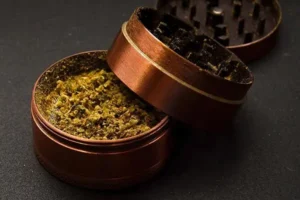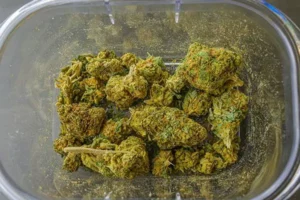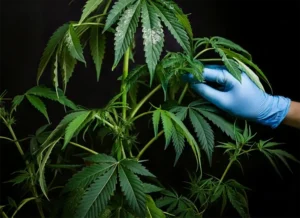How to Remove Mold from Buds?
The appearance of mold on buds is one of the most serious problems you can encounter when growing your cannabis plants. For this reason, at Sweets Seeds®, we are going to show you in detail how to remove mold from buds, and we will also share several tips on how to prevent it.
Additionally, we are about to cover everything you need to know in regards to mold in cannabis, including why it appears, how to prevent it, and how to eliminate it on time. Let’s dive in!
What is Mold?
The mold that affects cannabis, commonly known as “gray mold” or Botrytis Cinerea, is a fungus that can devastate grow operations of all kinds. It thrives in high-humidity conditions and can attack the flowers and leaves of the cannabis plant, reducing the quality and potency of the final product and making it unsafe for consumption due to significant health risks. Preventative control and humidity management are essential parameters to stop its spread.
However, in some cases, other species can also make an appearance. Keep reading, and you will become an expert in no time!
How to Detect Mold on Buds
Detecting mold on cannabis plants is relatively easy. Look for white or grayish spots with a powdery appearance on the leaves, flowers, or buds, or brown spots and gray or white fuzz on the buds. These patches often spread quickly and may be accompanied by an unpleasant odor. Additionally, pay attention to the plant’s wet, moldy texture. Regularly inspecting your plants is quite essential to catch any early signs of mold and take immediate action to eliminate it.
Different Types of Mold That can Grow on Buds
To understand how to remove mold from buds, first it is essential to become familiar with the wide variety of mold that can affect cannabis plants. This knowledge will help you act accordingly and on time, as each type has its own unique characteristics.
Below, we will provide all the details about the most common types of mold you might encounter in your grow operation:
Powdery Mildew
This fungal disease primarily attacks the youngest leaves and stems of cannabis plants.
Powdery Mildew is very easy to identify. Simply inspect the younger leaves and stems. If you notice a whitish or grayish layer with a powdery texture on them, it’s very likely that your cannabis grow has been affected by Powdery Mildew.
Its appearance is caused by a combination of factors, including weather conditions, the surrounding environment, and fertilization practices. Overuse of nitrogen-rich fertilizers, low light conditions, and excess humidity can all contribute to its development.
Botrytis
Botrytis, also known as gray mold, is commonly found on the largest and most compact buds of the cannabis plant. However, it can also affect other parts of the plant and can spread throughout the entire grow area. This fungus is highly destructive and can completely devastate cannabis crops.
For an accurate identification of a Botrytis infestation on cannabis plants, you should pay close attention to the following signs:
- Gray or brown spots: Look for areas on your plants with gray or brown discoloration, particularly on the leaves and buds.
- Spongy texture: Botrytis mold typically has a spongy, moist texture, resembling fuzz or cobwebs.
- Flower and bud decay: Check if the flowers and buds show any signs of decay, wilting, or rot.
- Gray fuzz: You may often notice a layer of gray fuzz covering the affected areas, especially in high-humidity conditions.
- Unpleasant odor: Botrytis can produce a stale, unpleasant smell in the infected areas.
- Affected leaves: It can also attack the leaves, causing brown or gray spots and weakening the plant.
Prevention is very important if we want to avoid a Botrytis infestation. Keep the environment dry and well-ventilated, avoid excessive humidity, and ensure your plants are spaced apart to allow for good air circulation. If you detect signs of Botrytis, carefully remove the affected areas and consider using specific fungicides to control the spread of the disease.
Downy Mildew
Another type of Mildew, known as “Downy Mildew,” is a fungal disease that can widely affect cannabis plants. It appears as a white powder, very similar to mold, that covers the leaves and stems. This fungus develops and thrives in high humidity and moderate temperatures.
When Downy Mildew attacks cannabis plants, the fungal spores penetrate the plant cells and multiply, weakening the plant by interfering with its ability to adequately perform photosynthesis and properly absorb nutrients. This can lead to a wide range of negative impacts to the cannabis plant, such as reduced vigor, decreased resin production, and ultimately, a lower quality and yield of buds.
Downy Mildew can spread rapidly if left unchecked. To prevent or treat it, it’s crucial to maintain a dry and well-ventilated environment, apply specific fungicides, and, if possible, choose the cannabis strains that are most resistant to the attack of different types of mold. Control and prevention are essential factors to protect cannabis grows from this disease.
Rust
Rust is a fungal disease that typically does not directly affect the flowers of cannabis plants. Rust tends to appear on the leaves, showing as orange or brown spots that contain fungal spores. These spots can weaken the cannabis plant by interfering with its ability to perform photosynthesis and it can also reduce the plant’s energy production.
While rust doesn’t usually impact the buds in a direct way, the overall weakening of the plant can make it more vulnerable to other diseases or issues, indirectly affecting yield and the final quality of the buds. Therefore, it is very important to monitor and treat Rust if it appears on the leaves to safeguard the plant’s health and production.
Pythium
Pythium is a type of fungus that includes several pathogenic species responsible for plant diseases, including those affecting the cannabis plant. One of the most common diseases caused by Pythium is root rot.
The main symptoms include wilting, yellowing leaves, brown and thin roots with a soft, mushy appearance. The plant may look wilted, similar to what we can observe when it lacks water.
The causes of Pythium infections are primarily linked to high soil moisture levels due to overwatering or poor drainage. Warm environments tend to further encourage the development of Pythium.
To prevent Pythium, you must ensure proper drainage for your plants and allow the soil to dry between waterings to maintain balanced humidity levels in the substrate. Using sterile substrates and avoiding the reuse of contaminated ones is also quite essential to an adequate prevention.
In conclusion, early detection and prevention are key to managing Pythium. By maintaining optimal growing conditions and closely monitoring symptoms, you can reduce the risk of this disease in your cannabis plants.
Fusarium
Fusarium is a type of fungi that can affect various plants, including cannabis. There are a good number of Fusarium species that can cause diseases like vascular wilt and root rot to our beloved plants.
The primary symptoms include wilting, often affecting only one side of the plant, discoloration of the leaves, necrotic spots, and, as the infection progresses, we can easily notice some sort of overall plant decline.
The causes of Fusarium infections can include contaminated soil, irrigation with infected water, or cuts and injuries to roots or stems that allow a doorway for the fungus to enter.
To prevent Fusarium, avoid growing your cannabis plants in the same soil affected by Fusarium for extended periods, prevent overwatering, and ensure good drainage. Using sterile substrates and disinfecting tools every time they are used, can also help prevent the introduction of the fungus. Managing Fusarium involves preventive growing practices and, in severe cases, the use of specific fungicides. Early detection and rapid intervention are critical when it comes to mitigate the effects of Fusarium on cannabis plants.
Tips to Prevent Mold on Buds
The first tip to prevent mold on your cannabis plants is to closely monitor them and detect any changes or symptoms of mold as early as possible, following the instructions we are sharing in this article.
Here are some tips on how to remove mold from buds and prevent it during the different stages of development of your cannabis plants:
Flowering
During this phase of their life cycle, cannabis plants are more prone to attacks from various fungi. To avoid this, we recommend maintaining the humidity levels below 50%, ensuring good ventilation that promotes proper airflow around the plants, keeping an optimal distance between the plants to avoid overcrowding, and pruning excess leaves or branches if they impede airflow, thus reducing areas prone to retaining moisture.
Lastly, maintain a temperature between 21°C and 28°C, avoid splashing water on the buds during watering, and use substrates that allow for proper drainage.
It is also very important to perform daily inspections to your plants, carefully looking for early signs of mold or pests that might promote fungal growth, along with maintaining good hygiene in the grow area. Personal cleanliness also significantly helps in reducing the risk of mold and fungi during the flowering stage of the marijuana plants.
Trimming
During the trimming process, you should remove as many leaves as possible. This action reduces the likelihood of mold development, as leaves and stems retain a significant amount of moisture.
Drying
This is a critically important phase, and if it is done correctly, it will significantly reduce the risk of mold appearing on the cannabis buds as they dry. The drying and curing processes are crucial for removing excess moisture from the buds.
Tips to properly dry your buds:
- Dry the buds for 7–15 days. Hang the plants separately or trim the buds with scissors and let them dry on cardboard or newspaper. You can also use drying racks, which help when it comes to having a better air circulation between the buds.
- The drying process requires darkness, so do it in a dark place with good ventilation.
- Ensure that the humidity levels remain between 45% and 55%.
Curing
Once you have correctly completed the drying process, place your buds in glass jars, preferably airtight, in a dry and dark area of the house.
To prevent mold from appearing, open the glass jars daily for a few minutes, to renew the air inside and to check that they have not become damp again. If this happens, keep the jar open for a few hours during a day with low humidity. Also, you can take advantage of this time to inspect your buds for small white spots, as this is one of the main signs to detect a mold infection.
Storage
The best option is to store your cannabis in airtight jars. Keep them stored in a cool, dry, and dark place.
The ideal temperature should be just below 25°C, with humidity levels between 58% and 62%.
In summary, proper drying, curing, and correct storage of your cannabis flowers will ensure your harvest remains mold-free.
Consequences of Consuming Cannabis with Mold
Ingesting cannabis with mold through any method can be highly harmful to your health. This is because mold contains thousands of spores that are known to be harmful to humans.
When consumed, there is an increased chance that some of these spores could lodge in your lungs, leading to severe infections. Other potential consequences of consuming cannabis with mold include:
- Sinusitis and congestion
- Fatigue or muscle weakness
- Confusion
For this reason, it is very important that you know how to remove mold from buds, as failing to detect and eliminate it could have serious consequences for your health.
How to Remove Mold from Buds
Once we have detected mold on our buds, two questions arise: Can I consume it? Can I remove it? Both questions have the exact same answer: NO.
The presence of mold on cannabis buds is a very serious issue, as consuming it can be harmful to your health. Therefore, it is not recommended to consume buds affected by mold in any form or shape.
If you encounter buds with mold, the best course of action is to dispose of them safely to avoid health risks. It is not possible to effectively remove mold from buds without compromising the quality and safety of the final product.
On the internet, you will find numerous articles offering solutions on how to remove mold from buds with supposedly positive results. However, at Sweet Seeds®, we are certain that none of these methods are foolproof, and traces of mold may remain, making the buds unsuitable for consumption. Some of the commonly suggested methods include cleaning with boiling water or using an oven.
Here are some good reasons to avoid these methods:
- Boiling water: Boiling water does not guarantee the complete elimination of mold and its toxins. Additionally, it can damage the cannabinoids and terpenes in the buds, affecting their quality and potency. Moreover, the heat can cause toxins to spread through the steam, which could be inhaled and harmful to your health.
- Oven: Using an oven brings the risk of excessively drying the buds and degrading the active compounds in cannabis, such as cannabinoids and terpenes. Furthermore, the oven’s heat does not ensure the complete removal of mold toxins in any way.
To address the issue of mold on buds, the best practice is to safely discard the affected buds and prevent future issues in your next cannabis growing operations by properly controlling growing conditions. Safety and quality are essential when it comes to consuming cannabis, and the cleaning methods showing how to remove mold from buds are neither effective nor safe for ensuring a mold-free and safe product for consumption.
Contact Us
Now you already have all the information and tips on how to remove mold from buds. Preventing and detecting fungal attacks on your cannabis plants in time is essential to save your grow and guarantee the finest quality of your final product.
At Sweet Seeds®, we offer high-quality photoperiod-dependent and autoflowering feminized cannabis seeds for collectors. These seeds have passed rigorous quality controls to ensure they produce vigorous plants capable of resisting fungal attacks, thus guaranteeing healthy and well-controlled results.
If you have any questions or issues regarding this or other subjects, feel free to contact us directly through our website or on the Sweet Seeds® online forum.
Sweet Seeds S.L. is not responsible for any misuse of the information provided in this article. Growing Cannabis may constitute a criminal offense or administrative infraction; please check the Cannabis legislation applicable in your place of residence. Sweet Seeds S.L. does not, under any circumstances, intend to promote illegal practices.




